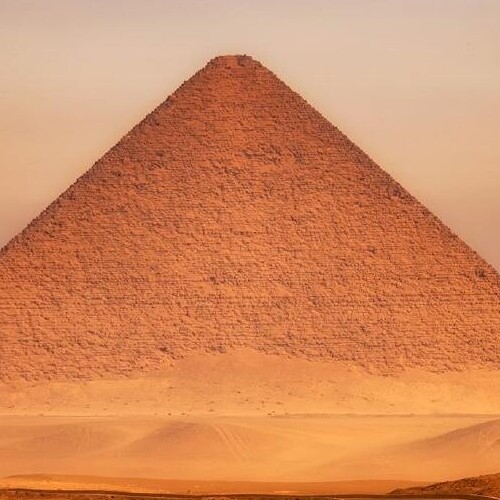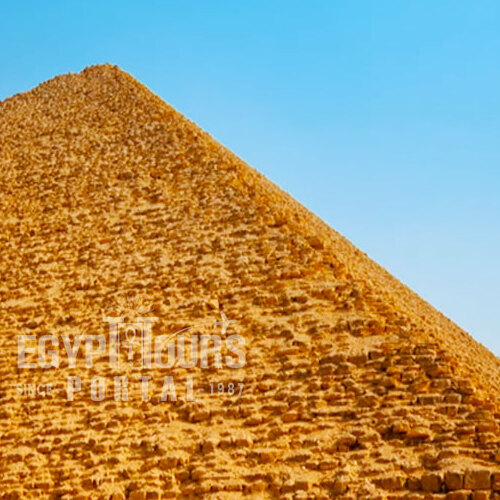No other nation in the world says ‘Welcome’ as often as the Egyptians, and every time, they mean it. While the ancient civilization of Egypt continues to amaze, contemporary Egyptians are equally remarkable.
The Red Pyramid
The Majestic Red Pyramid: Snefru's Triumph in Stone
In the timeless expanse of Dahshur, the renowned pharaoh Snefru, ever the visionary, embarked on yet another ambitious pyramid construction project, following the enigmatic Bent Pyramid. This awe-inspiring structure, standing resolute approximately 4 kilometers north of Dahshur, bears the name “Red Pyramid” or simply “North Pyramid” in recognition of its northern location.
Interestingly, the Red Pyramid marked the third pyramid project in Snefru’s legacy, with the first being the ill-fated endeavor at Meidum. However, it holds the distinction of being the second pyramid successfully completed by the determined pharaoh. In ancient times, it was known as “Snefru Shrines,” a name that resonated with the awe it inspired.
As Snefru’s architects and builders embarked on the Red Pyramid, their experience and technical prowess had matured through their prior undertakings. The plans for this pyramid bore a more pragmatic approach from the outset, resulting in reduced slope angles—a testament to the lessons learned from earlier endeavors.
One of the most intriguing aspects of the Red Pyramid lies within its blocks, adorned with markings that seem to bear the fingerprints of its architects and builders. These inscriptions, resembling dates, are believed to chronicle the duration of the pyramid’s construction. Based on this evidence, it is likely that the construction of the Red Pyramid commenced during the 30th year of Snefru’s rule.
The name “Red Pyramid” finds its origin in the core of the structure, which is constructed from striking red limestone. Originally encased in luminous white limestone, the years have eroded this outer layer, leaving the core exposed to the elements.
The Red Pyramid boasts impressive dimensions, with each side measuring a substantial 220 meters and an initial height of 104 meters. In a recent excavation, a team of German archaeologists unearthed the capstone remnants of this magnificent edifice. The capstone was meticulously reconstructed and now proudly adorns the eastern side of the pyramid.
A small horizontal passageway beckons those who venture into the pyramid, leading to the burial chamber. It is within the confines of the second antechamber, positioned approximately 8 meters above the floor, that intrigue abounds. The German archaeological team’s findings initially suggested that this might be the resting place of the pharaoh, as they discovered human bone fragments within the passageway. However, subsequent investigations have revealed that this intrusion occurred during the Late Period, a perplexing twist in the pyramid’s tale.
Other teams of archaeologists, in contrast, propose that the true burial site of the pharaoh lies within the Bent Pyramid. This pyramid houses a burial chamber oriented from east to west, a departure from the Third Dynasty pyramid design. The particular burial chamber is distinguished by its soaring 16-meter-high vaulted ceiling, lending an air of grandeur and solemnity to this sacred space.
To the east of the Red Pyramid, a mortuary temple stands as a testament to the swift construction that followed the pharaoh’s demise. The German archaeological team envisions the temple’s resurrection, utilizing the existing remnants. Among these remnants, a pink granite false door stela bears silent witness to a bygone era. Fragments from mudbrick-based storage rooms and the presence of a Sed Festival provide further glimpses into the rituals and ceremonies that once graced this hallowed ground.
The complex was once enclosed by a rectangular wall, and traces of an unfinished causeway were discovered near the valley temple. The presence of construction ramps linking the Nile Valley and the mortuary temple adds to the architectural intrigue.
In the early 20th century, as construction activities unfolded along the Nile Valley, an astonishing discovery emerged at the valley’s edge—an ancient pyramid town bearing the name of Snefru. Though pieces of a valley temple were unearthed, they have since vanished from the sands of time. Nonetheless, researchers delving into the town’s ruins unearthed a remarkable limestone stela bearing a written decree from King Pepi I, a testament to the town’s significance and a royal gift of tax exemption.
The Red Pyramid, with its timeless allure and enduring mysteries, stands as a tribute to the audacious spirit of its builder, a testament to the resilience of ancient Egyptian engineering, and an enigmatic marvel awaiting the exploration of those who seek to unlock its secrets.
Created On March 18, 2020
Updated On July 22 , 2025



